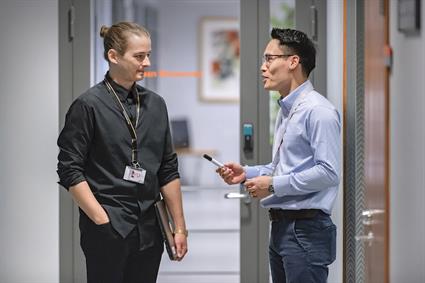

RPA has been deployed in almost every corner of Wärtsilä’s organisation. With well over 100 RPAs running and tens of thousands of person-hours saved last year, in business units as well as support functions, Wärtsilä has reached a point where RPA is starting to become an integral part of the company’s DNA.
RPA can be implemented anywhere from the factory floor to support functions, and it can use practically any software application. It is used in various fields such as balance processing, liability claims, sales orders, and project management. These virtual assistants have made it possible for employees to eliminate tedious routine tasks and instead focus on more productive and creative responsibilities.
“Compared with only a year ago, RPA is very different today. It’s much more structured and organised. Thanks to a user-friendly software solution, almost everyone can contribute. Therefore, RPA is used in a wide range of areas,” says Hieu Ta Minh, Development Manager, Product Information Life Cycle and RPA at Marine Solutions.
Eliminating the risk of human error
It is easy to think of RPA as only a productivity tool, but one fundamental aspect is the improvement of quality. The RPA experts at Wärtsilä strive to refine the pieces of code sequences so that they can be safely reused in the knowledge that they work as intended. A robot does not do anything randomly, it is consistent in its work, so if it is configured right, it will not make any mistakes.
“When the user picks a building block of code sequences from the common repository, the system creates a link to the original block. Maintenance-wise, this is a big benefit, since updates are done only in one place, the repository,” explains Ville Lehtinen, Solution Expert, Data and Analytics Services at Wärtsilä’s Information Management.
Improved quality is not the only business benefit. The robot is also a lot faster than a human, enabling the business to respond earlier to different parties. Also, RPAs can be configured to use virtually any application from Enterprise resource planning (ERP) systems, Office applications, Product Data Management (PDM) cloud applications to even third-party elements.
“In a typical project, an employee went through thousands of lines, collected several hundred documents and sent them to a subcontractor. This used to take hours and days to complete; and whenever there were revisions the person had to do the same task all over again. Now the robot does this in a tiny fraction of that time,” says Ta Minh.
Ville Lehtinen, Solution Expert, Data and Analytics Services at Wärtsilä’s Information Management and Hieu Ta Minh, Development Manager, Product Information Life Cycle and RPA at Marine Solutions.
RPA will be part of the digital workforce
Wärtsilä’s top management fully supports RPA implementation. Besides economic savings, improved quality and faster response times, updated and improved process descriptions have often been a by-product of RPA.
Most of us would like to have more time to develop and improve our work. Moreover, wouldn’t you love to have a virtual assistant providing you with extra superpowers to do that? In 2-3 years, RPA will not be a term, but something we do daily; our digital colleague.
“In the places that we run RPAs we have happy stakeholders, and we have reached a level where the pull factor is higher than push,” says Ta Minh.
RPA will take Wärtsilä into the digital age, where the employees can provide customers with more value-added services. “On a personal level, it would be good to have a personalised RPA that would increase your productivity,” says Lehtinen with a smile.
Simplified example of RPA instructions
- Check emails. Specified message or variable triggers next action.
- Launch application X, Y...
- Do activities in applications
- If an error occurs, store error information in a report and move to Step 7. Otherwise proceed to next activities.
- (…)
- Store transaction result in a report.
- Pick next transaction and return to Step 3.
Did you like this? Subscribe to Insights updates!
Once every six weeks, you will get the top picks – the latest and the greatest pieces – from this Insights channel by email.


